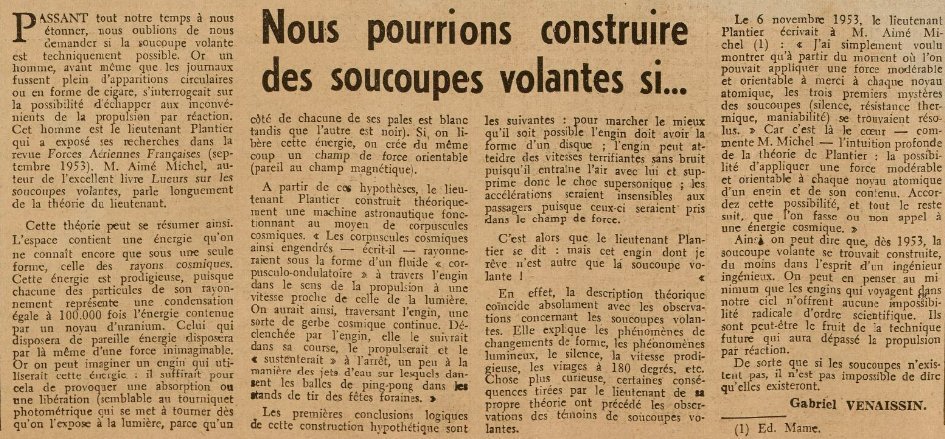The article below was published in the daily newspaper Combat, Paris, France, page 1, on October 18, 1954.

|
Spending all our time being amazed, we forget to ask ourselves whether the flying saucer is technically possible. Yet one man, even before newspapers were filled with circular or cigar-shaped sightings, had already begun questioning the drawbacks of jet propulsion. That man is Lieutenant Plantier, who presented his research in the journal *Forces Aériennes Françaises* (September 1953). Mr. Aimé Michel, author of the excellent book *Lueurs sur les soucoupes volantes*, discusses the lieutenant’s theory at length.
This theory is summarized as follows. Space contains an energy we currently only know in one form: cosmic rays. This energy is tremendous—each particle of cosmic radiation represents a condensation equal to 100,000 times the energy contained in a uranium nucleus. Whoever can harness such energy would possess unimaginable power. One can envision a craft that utilizes this energy: it would only require the triggering of an absorption or release (like the photometric rotor that starts spinning when exposed to light, because one side of its blades is black and the other white). If this energy is released, a directed force field is created (similar to a magnetic field).
From these assumptions, Lieutenant Plantier theoretically constructs an astronautic machine powered by cosmic particles. “The cosmic particles thus generated,” he writes, “would radiate in the form of a wave-like particle fluid through the craft in the direction of propulsion at a speed near that of light. This would create a sort of continuous cosmic jet traversing the craft. Triggered by the craft, it would follow it in flight, propel it, and keep it suspended while stationary—somewhat like the water jets on which ping-pong balls dance at carnival shooting galleries.”
The first logical conclusions from this hypothetical construction are as follows: for optimal functioning, the craft must have a disc shape; it could reach terrifying speeds without making noise, as it would carry its own atmosphere and thus eliminate the supersonic bang; acceleration would be imperceptible to passengers, as they would be enclosed within the force field.
It is then that Lieutenant Plantier realizes: the craft he dreams of is none other than the flying saucer!
Indeed, the theoretical description aligns perfectly with the reports of flying saucer sightings. It explains shape-shifting phenomena, luminosity, silence, astonishing speeds, 180-degree turns, etc. More curiously, some of the consequences Plantier deduced from his theory came before any such behaviors were described by eyewitnesses of flying saucers.
On November 6, 1953, Lieutenant Plantier wrote to Mr. Aimé Michel (1): “I simply wanted to show that from the moment one could apply a modifiable and directional force at will to each atomic nucleus, the first three mysteries of flying saucers (silence, thermal resistance, maneuverability) would be resolved.” For that, says Mr. Michel, is the core—the deep intuition—of Plantier’s theory: the possibility of applying a controlled and directional force to every atomic nucleus of a craft and its contents. Grant that possibility, and everything else follows, whether or not one invokes cosmic energy.
Thus, one could say that as early as 1953, the flying saucer was already constructed—at least in the mind of an ingenious engineer. At the very least, one may conclude that the craft flying through our skies present no radical scientific impossibility. They might simply be the product of a future technology that has surpassed jet propulsion.
So even if flying saucers do not exist, it is not impossible to say that they will.
Gabriel VENAISSIN.
(1) Ed. Mame.